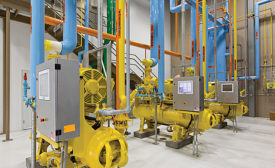Tech Update
Tech Update: Filling Equipment
New filling machines are maximizing output and simplifying changeovers
Read More
Tech Update: Machine Controls
How suppliers are creating better machine control systems
Today's machines communicate with rest of your plant equipment.
September 20, 2016
Tech Update: Lubricants
Food-grade lubricants: When simple is smart
The argument for using nothing but food-grade lubricants is stronger than ever before.
August 12, 2016
Tech Update: Cooling & Freezing
Preserving quality and safety
As consumers demand food and beverage products made with fresher ingredients, refrigeration and freezing technology becomes more important.
May 20, 2016
Tech Update: Cleaning & Sanitation
Boost plant efficiency by being clean, safe and savvy
Risks will always exist, but combining technology and employee training ensures processes not only comply with, but exceed, increasingly stringent regulatory standards.
March 25, 2016
Tech Update: Collaborative Robots
Tech update: Don't fence them in
Some robots find new freedom as they become aware of their surroundings and act accordingly.
January 13, 2016
Tech Update: Refrigeration & Freezing
The shift to natural cooling systems
Big changes are in store as many synthetic refrigerants still widely in use could be phased out next year by the EPA.
October 20, 2015
Tech Update
Tech update: Meeting great expectations
As consumers want a bigger variety of healthier choices that come in a plethora of sizes, manufacturers are offering fillers that are flexible while producing optimal output.
September 14, 2015
Tech Update
Optical Inspection: A finer line of separation
Vision technology improves product quality and manufacturing efficiency in multiple areas of the processing plant.
August 25, 2015
Tech Update
Electrical systems and components: The lifeblood of your facility
Electrical systems and components run in the background, keeping your plant energized, but without maintenance and attention, things can go wrong.
June 5, 2015
Elevate your expertise in food engineering with unparalleled insights and connections.
Get the latest industry updates tailored your way.
JOIN TODAY!Copyright ©2024. All Rights Reserved BNP Media.
Design, CMS, Hosting & Web Development :: ePublishing












